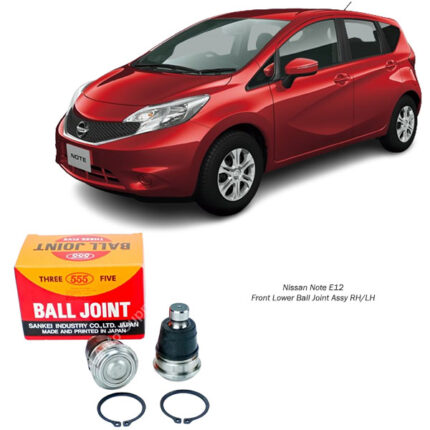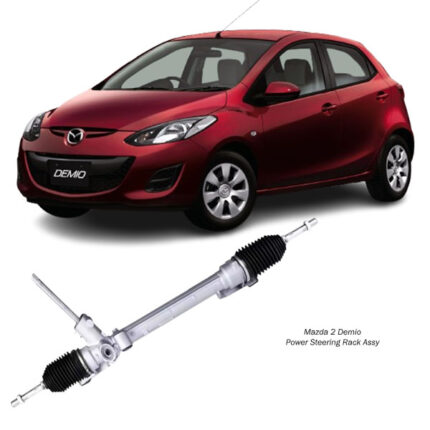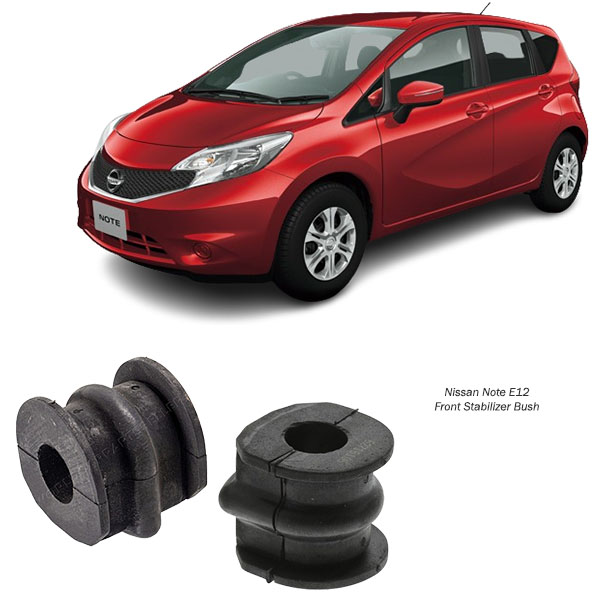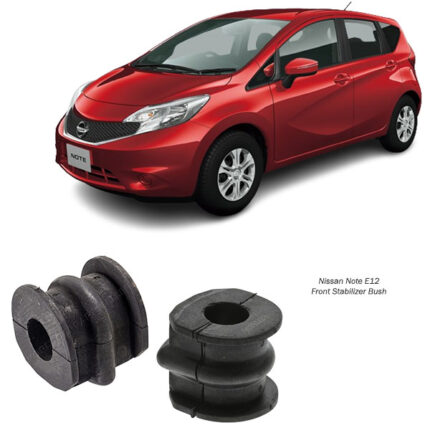Get Nissan Note E12 Front Stabilizer Bush 54613-1HA0A in Kenya
The front stabilizer bush (also known as the anti-roll bar bushing) is a small but crucial component of the suspension system in the Nissan Note E12. It plays an essential role in reducing body roll, improving stability, and enhancing ride comfort by securing the stabilizer bar to the chassis.
When the stabilizer bush wears out, you may notice increased body roll, clunking noises, and poor handling. This guide will provide an in-depth look at the front stabilizer bush, including its function, types, symptoms of failure, causes of wear, and a step-by-step replacement guide.
1. What Is a Front Stabilizer Bush?
The front stabilizer bush is a rubber or polyurethane component that cushions and secures the stabilizer bar (also known as the anti-roll bar or sway bar) to the vehicle’s frame.
1.1 Role of the Front Stabilizer Bush
Prevents metal-on-metal contact between the stabilizer bar and the chassis.
Absorbs vibrations and road shocks, improving ride comfort.
Reduces excessive body roll during cornering.
Maintains suspension alignment and improves handling.
Fun Fact: The stabilizer bush acts like a cushion, ensuring the anti-roll bar moves smoothly while limiting excess movement!
2. How the Front Stabilizer Bush Works
The stabilizer bar connects the left and right front wheels and reduces body roll when the vehicle turns. The bushings secure the stabilizer bar to the chassis while allowing some controlled movement.
Step-by-Step Function:
When you drive straight, the stabilizer bar remains level, and the bushings allow slight movement.
During a turn, weight shifts to one side, causing the suspension on one side to compress and the other to extend.
The stabilizer bar transfers some of this force to the opposite side, reducing body roll.
The bushings provide flexibility and absorb vibrations, preventing harsh movements.
3. Types of Front Stabilizer Bushes
There are two main types of stabilizer bushes used in the Nissan Note E12:
3.1 Rubber Stabilizer Bushes
Factory-installed OEM bushings
Provide good ride comfort and noise dampening
Absorbs vibrations well
Wears out faster than polyurethane
Can crack and deteriorate over time
3.2 Polyurethane (PU) Stabilizer Bushes
More durable than rubber
Provides better handling and stability
Resistant to oil, heat, and road debris
Can be stiffer, leading to slightly more vibration
May require occasional lubrication
Tip: If you prioritize comfort, stick to rubber bushes. If you want better handling and longevity, consider polyurethane upgrades.
4. Symptoms of a Failing Front Stabilizer Bush
A worn-out stabilizer bush can cause handling problems and noises. Look out for these warning signs:
4.1 Clunking or Knocking Noises
- Loud clunking sounds when driving over bumps or uneven roads.
- The stabilizer bar is moving excessively due to worn-out bushings.
4.2 Excessive Body Roll
- The vehicle leans too much when turning.
- Reduced cornering stability, making the car feel less secure.
4.3 Poor Steering Response
- Steering feels vague or less precise.
- A delay in vehicle response during turns.
4.4 Uneven Tire Wear
- Excess movement in the suspension causes irregular tire wear.
4.5 Squeaking or Creaking Noises
- Dry or cracked bushings rub against the metal stabilizer bar, creating noise.
Warning: Ignoring worn-out stabilizer bushes can lead to poor handling and increased risk of losing control in emergency situations!
5. Causes of Front Stabilizer Bush Failure
5.1 Normal Wear & Tear
- Rubber bushings harden, crack, and degrade over time.
5.2 Exposure to Heat & Chemicals
- Oil leaks, road salt, and extreme heat break down rubber over time.
5.3 Rough Road Conditions
- Frequent driving on bumpy or uneven roads accelerates wear.
5.4 Overloading the Vehicle
- Excess weight increases stress on suspension components, speeding up deterioration.
Tip: Regularly inspect bushings for cracks or signs of wear to catch issues early.
6. How to Replace the Front Stabilizer Bush on a Nissan Note E12
Replacing the stabilizer bush is a moderate DIY job if you have the right tools.
6.1 Tools Required
Jack & jack stands
Wrench set
Socket set & breaker bar
Pry bar (for leverage)
New stabilizer bushings
6.2 Step-by-Step Guide
Loosen the front lug nuts before lifting the vehicle.
Jack up the front of the car and secure it with jack stands.
Locate the front stabilizer bar under the vehicle.
Remove the stabilizer bar mounting brackets (two bolts per bracket).
Pull out the old bushings and inspect them for cracks or wear.
Install the new stabilizer bushes (lubricate if using polyurethane).
Reattach the stabilizer bar brackets and tighten the bolts securely.
Reinstall the wheels and lower the vehicle.
Test drive to check for any noises or handling issues.
Warning: Make sure the bushings are properly aligned to avoid premature wear!
7. Maintenance Tips for a Long-Lasting Stabilizer Bush
Inspect bushings every 20,000 km or during routine servicing.
Listen for unusual noises while driving over bumps.
Avoid driving through deep water or oil spills, which can weaken rubber bushings.
Check for cracked or dried-out bushings every 6 months.
Use polyurethane bushings if driving on rough roads frequently.
By following these tips, you can extend the lifespan of your stabilizer bushes and ensure smooth, controlled handling!
Follow us on Facebook for more parts.





Reviews
Clear filtersThere are no reviews yet.